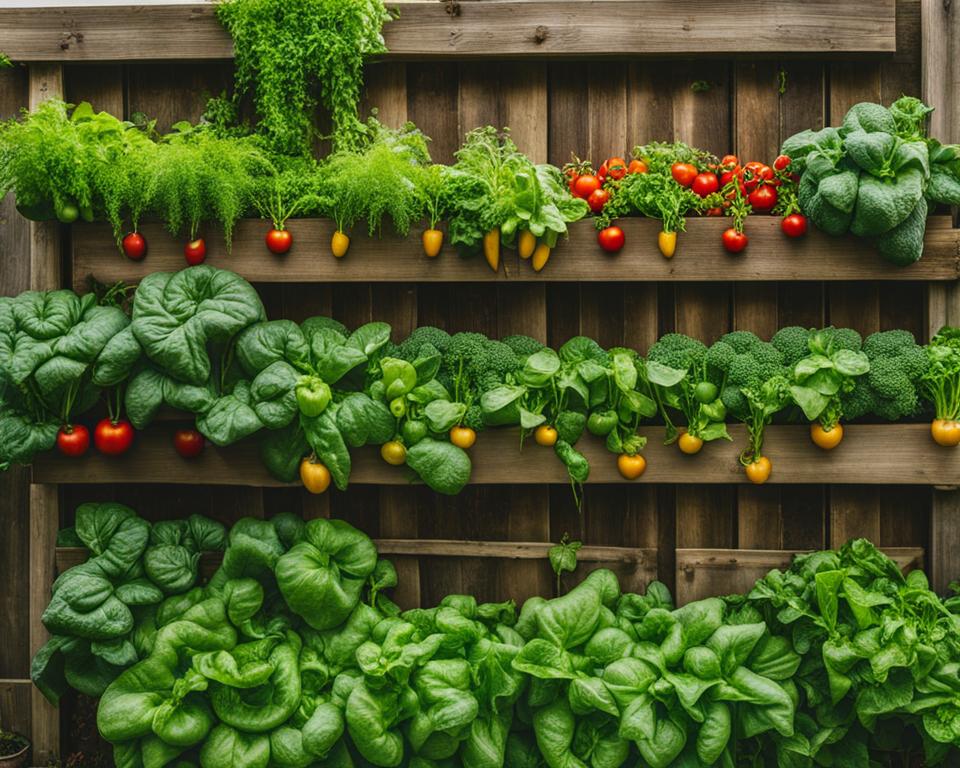If you’re intrigued by the idea of cultivating your own fresh produce but are constrained by limited outdoor space, vertical gardening might just be the solution you’re seeking. This innovative approach centers around vertical gardening vegetables, where thriving plants ascend skyward, offering you a lush, green bounty in places where traditional gardens would falter. Whether you’re an apartment dweller with a petite balcony or a homeowner seeking to maximize your garden’s footprint, mastering vertical gardening tips can transform the way you think about and interact with your gardening space.
Wondering how to start vertical gardening? It’s simpler than you might think. Using vertical structures like trellises and pallets, you can train a variety of vegetables to grow up rather than out. This method not only conserves precious ground space but also potentially reduces your garden chores. You’ll find yourself bending and kneeling less, harvesting more easily, and enjoying an uplifted view of your vibrant veggies as they reach for the sun. However, as your garden grows upwards, staying vigilant with watering and choosing the right irrigation system will ensure your vertical oasis thrives.
Key Takeaways
- Vertical gardening is an exceptional option for growing vegetables in areas with limited space.
- Employ structures such as trellises or pallet gardens to train plants to grow upwards.
- Increased air circulation and sun exposure from vertical gardening can lead to healthier plants and fewer diseases.
- Vertical gardens might require more frequent watering; consider a micro-irrigation system for moisture management.
- To kickstart your vertical garden, focus on vegetables that are natural climbers or can be easily supported with structures.
The Rising Popularity of Vertical Gardening
Amidst the concrete jungle, a green revolution is flourishing as vertical vegetable gardening for beginners transforms small urban spaces into verdant sanctuaries. The concept of growing vegetables in small spaces has taken an innovative turn skyward, making the dream of a personal garden attainable for city dwellers. A symbiosis of form and function, these vertical oases extend beyond their aesthetic allure, bestowing a wealth of vertical gardening benefits into the lives of the urban populace.
Space Efficiency: The Urban Gardening Revolution
As metropolitan areas swell and living quarters shrink, the ingenious approach of vertical gardening comes as a saving grace. It maximizes every inch of your petite patio, balcony, or courtyard, enabling you to harvest an abundance of fresh produce right at your doorstep. If you’re plunging into gardening, fear not—the principles of vertical vegetable gardening for beginners are simple and scalable, catering to both novice and seasoned green thumbs alike.
By repurposing vertical real estate for growth, you sidestep the limitations of horizontal expanses, introducing a new dimension of productivity; where once only decorative plants might have hung, now tomatoes, beans, and an array of herbs can ascend towards the sun.
Ecological Benefits: Sustainability Meets Aesthetics
Vertical gardens are more than just a space-saving solution; they encapsulate the pinnacle of urban sustainability. This convergence of environmental stewardship and design elegance magnetizes biodiversity, supports local ecosystems, and can even moderate the microclimate of your urban abode. The benefits of merging sustainability with aesthetics through vertical gardening are manifold, ranging from improved air quality to the sheer joy of growing your own food.
The union of function and beauty in vertical gardens elevates them from mere cultivation spaces to living artworks that contribute to the well-being of both residents and the environment.
Let’s take a closer look at how vertical gardening is reshaping modern urban landscapes:
| Aspect | Advantage | Example |
|---|---|---|
| Space Usage | Efficient area utilization | Wall planters, vertical rows |
| Sustainability | Local produce reduces carbon footprint | Homegrown veggies |
| Aesthetics | Adds greenery and charm to living spaces | Edible landscapes |
| Biodiversity | Attracts pollinators | Flowering vines amidst vegetables |
| Microclimate | Plants can cool urban dwellings in summer | Shade provided by vertical foliage |
In conclusion, vertical vegetable gardening for beginners is rapidly elevating the standards of urban agriculture and sustainable living. Witness the fusion of nature and metropolitan modernity through the lens of vertical gardening, and marvel at the transformation of underutilized spaces into thriving food sources with impressive ecological aesthetics.
Understanding Vertical Gardening Vegetables
When you embark on the journey of vertical gardening, the importance of choosing the best vegetables for vertical gardening cannot be overstated. As your intent is to maximize your harvest in minimal space, focusing on crops that are predisposed to climbing, or ones that can be supported to grow upwards is fundamental. Let’s delve into some vertical gardening ideas that will help you flourish in your green endeavor.
Take for instance pole beans and sweet peas; these are quintessential vining vegetables that rise up with the help of tendrils, seizing every inch of vertical territory. Their innate climbing nature makes them top candidates for vertical gardens. Similarly, cucumbers, with their sprawling vines, become docile and directionally obedient when provided with vertical structures like trellises or nettings.
- Pole beans
- Climbing peas
- Cucumbers
A sound vertical setup not only optimizes your space but also facilitates easy picking and maintenance. It provides a reliable framework for your vegetables to climb, reducing the susceptibility of plants to soil-borne diseases. The position of your garden and the pattern in which the plants grow, fully exposed to natural sunlight, becomes a proven strategy for healthier and more vigorous plant growth. Hence, understanding the specific growth habits of each vegetable should become the cornerstone of your vertical garden planning.
To amplify your available space, consider these sturdy climbers that are not just productive but ornamental too:
| Vegetable | Growth Habit | Support Structure |
|---|---|---|
| Pole Beans | Vining with tendrils | Stakes, Trellises |
| Climbing Peas | Twinning vines | Netting, Trellises |
| Cucumbers | Scrambling vines | Vertical frames, A-frames |
Remember that choosing the right vegetables is only part of the equation. Equally important is crafting a vertical ambiance that caters to the growth patterns and structural needs of your greenery. So, as you explore various vertical gardening ideas, prioritize plant health and productivity to craft a garden that’s not only a marvel of efficiency but also a testament to your horticultural acumen.
Essentials of Vertical Vegetable Garden Design
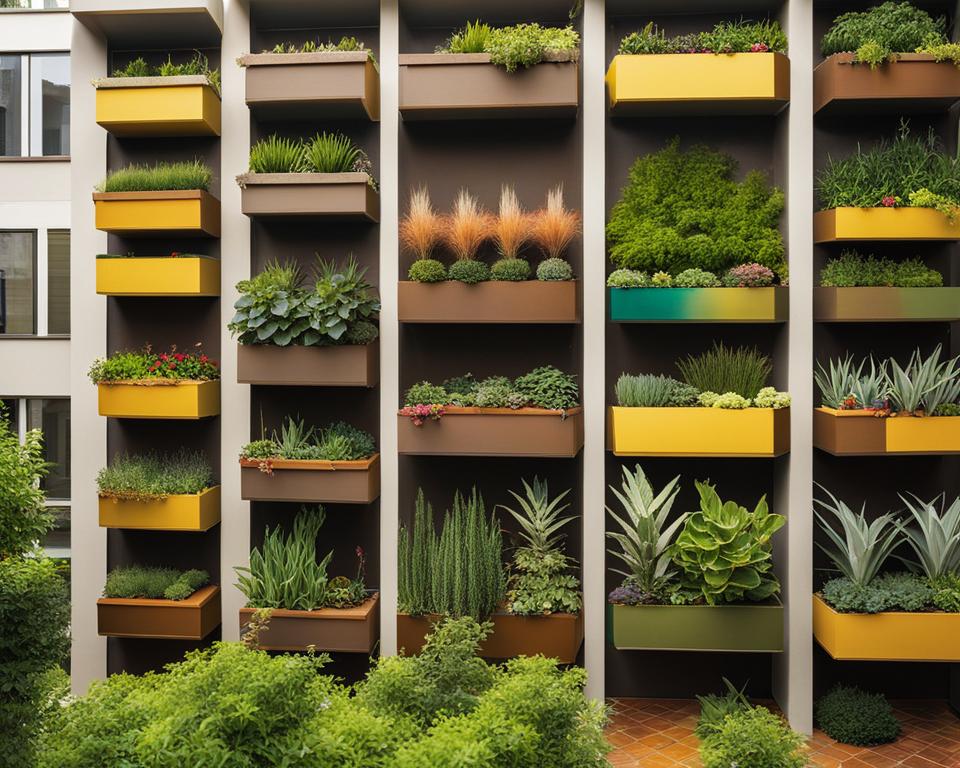
Maximizing your gardening space and reaching for the sky with vertical vegetable garden design involves more than just aesthetics; it’s about harnessing the power of vertical gardening techniques for thriving plant life. Ensuring your plants have access to sufficient sunlight and are supported by structures tailored to their needs is paramount for a bountiful harvest.
Choosing the Right Location for Sunlight and Shade
As you embark on crafting your vertical garden, consider the movement of the sun across your space. Select a site that captures 6 to 8 hours of sunlight daily, preferably during the midday or afternoon when the rays are at their strongest. This will not only optimize photosynthesis but will also warm your plants, warding off diseases and nurturing them to maturity.
Structural Support: Durability Meets Design
Integrating strong, enduring support systems are crucial. Your chosen structures, from lean trellises to robust arches, should blend durability with design, providing secure anchorage for climbing vegetables to flourish. The materials need to withstand not just the weight of plant growth but also the elements they will face throughout the growing season.
| Vegetable | Type of Support Structure | Design Considerations |
|---|---|---|
| Pole Beans | Trellis | Lightweight materials, easily movable |
| Cucumbers | Wire A-Frame | Allows for growth on both sides, easy harvesting |
| Tall Peas | Netting | Flexible support for tendrils |
| Grapevines | Arches or Pergolas | Sturdy construction to support weight over years |
| Small Squashes | Vertical Grids | Modular frames to handle fruit size and weight |
Vertical Gardening Techniques for Unbeatable Yields
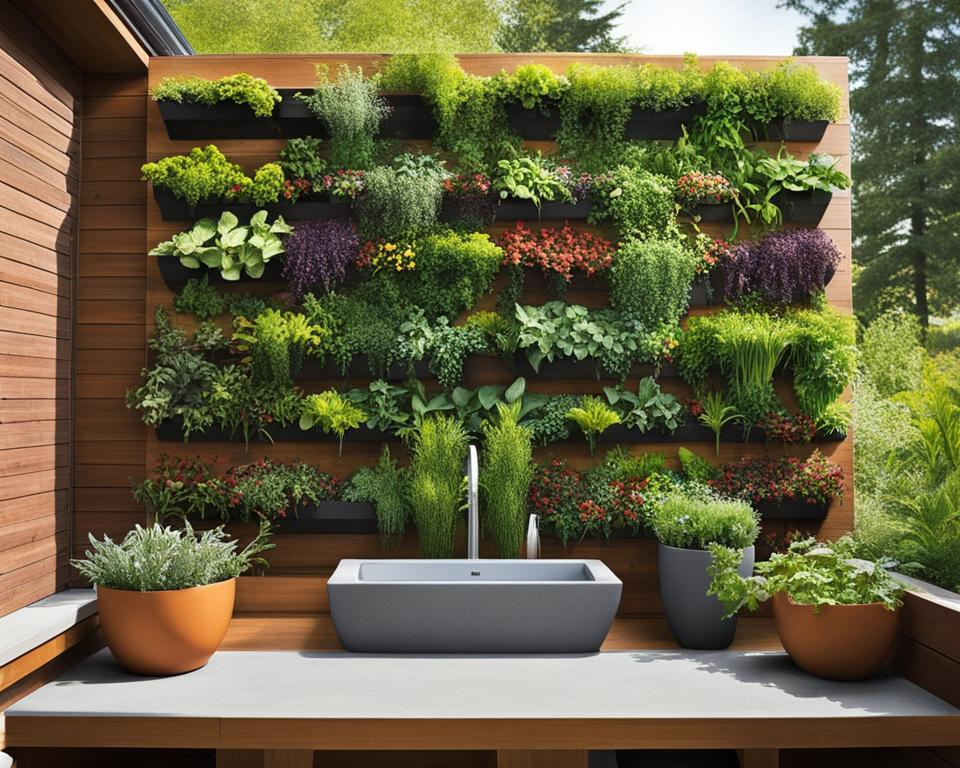
If you’re diving into the world of vertical gardens, mastering vertical gardening techniques is pivotal for boosting your yields. In fact, the strategic arrangement of plants and thoughtful selection of supporting structures can make a significant difference in your gardening success. Let’s delve into how these techniques can optimize every square inch of your vertical space for lush, productive growth.
Training vines onto sturdy supports such as trellises and arches not only maximizes garden space but promotes vigorous and healthier plants. Properly exposed to sunlight and benefiting from improved air circulation, these vertically nurtured vegetables are less prone to disease and pests.
- Utilize trellises for climbing vegetables like cucumbers and pole beans, allowing them to reach towards the sun naturally.
- Empower vining plants with garden arches that support their weight and enhance your garden’s aesthetic.
- Implement vertical nets or strings for lighter plants to ensure they have sufficient support without unnecessary bulk.
When it comes to harvesting, plants grown vertically offer ease of access, making the process less labor-intensive and reducing the chances of overlooking ripe produce. Furthermore, monitoring for pests and diseases becomes a simpler task when plants are at eye level and not obstructed by ground foliage.
By using vertical gardening techniques, you not only maximize your harvesting potential but also craft a garden that’s a delight to manage and a vision of vertical vibrancy.
How to Start Vertical Gardening: A Step-by-Step Guide
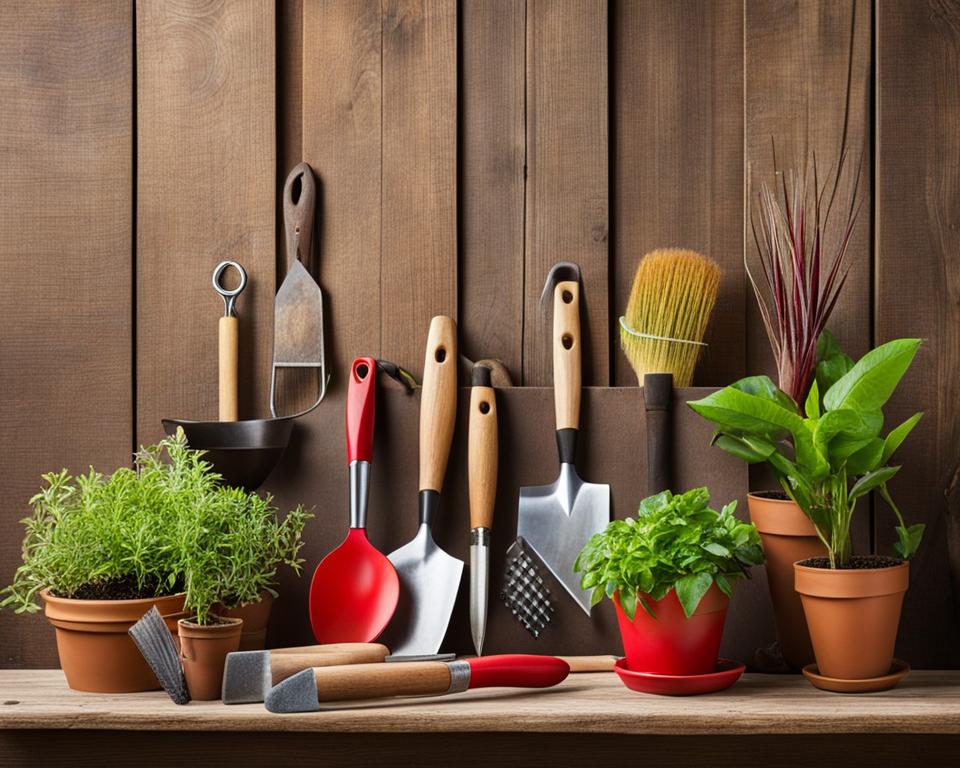
Embarking on the vertical gardening journey transforms your spatial constraints into lush vertical landscapes. Forget sprawling gardens; think upwards! As you learn how to start vertical gardening, you unlock the potential to grow more greenery despite limited horizontal spaces. Here’s how to get your garden off the ground—literally.
Preparing Your Space: From Planning to Planting
Begin with a thorough evaluation of your gardening area. Seek out spaces that receive sufficient sunlight, as a well-lit area is critical for plant health and productivity. Consider existing vertical elements such as walls or fences, which can be potential supports for your new green architecture. When planning, always remember the requirements of the plants you wish to cultivate in terms of light, water, and trellising needs.
Installation of Vertical Structures
Selecting and installing the right type of vertical structures is a game-changer. Sturdy trellises, garden netting, or wall planters are just the beginning. Each structure must be securely installed to withstand the weight of soil, water, and mature plants. To fortify your vertical garden’s resilience, ensure all structures are anchored firmly in place, equipped to support the verdant towers your garden will become.
Planting Strategies for Vertical Growth
When it’s time to plant, your strategies for vertical growth are paramount. Employ climbing varieties and those amenable to training upwards to utilize every vertical inch. Regular pruning and guiding of tendrils will help maximize sunlight exposure and prevent overcrowding. Developing a watering routine that reaches all vertical levels efficiently will keep your garden vibrant and thriving.
With careful planning, sturdy infrastructure, and strategic planting, your vertical garden can become a verdant oasis, ascending towards the sun and bringing life to any small space. Now that you’re equipped with the knowledge, see how high your garden can grow!
Best Vegetables for Vertical Gardening
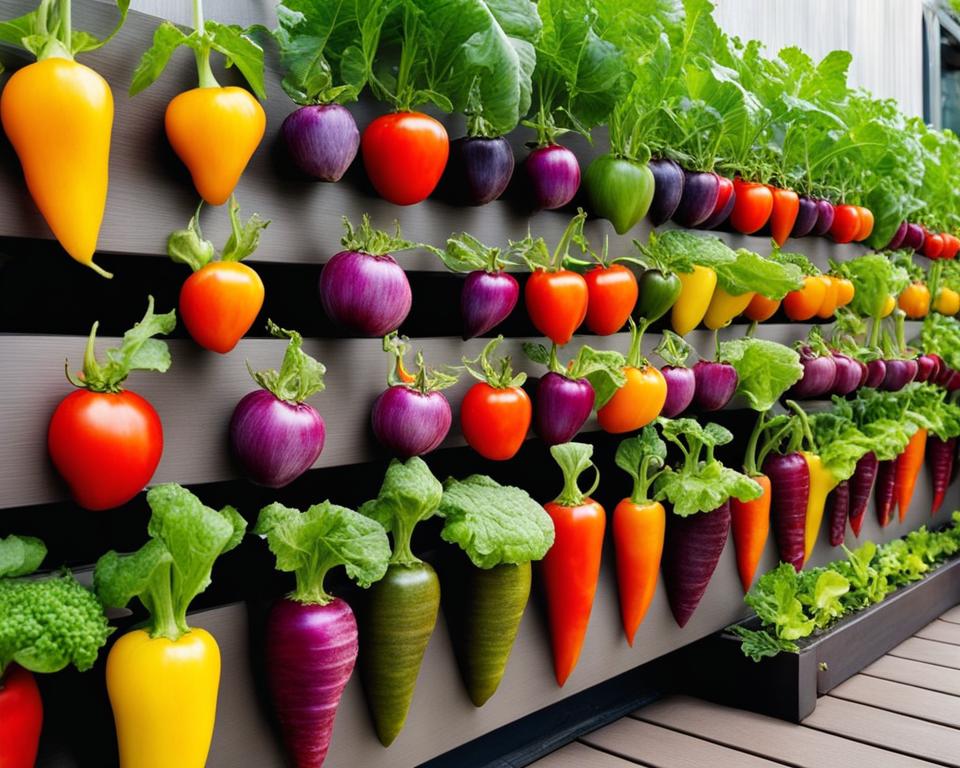
Exploring the world of vertical gardening opens up a new realm of possibilities, especially when it comes to selecting the right vegetables that will thrive as they climb. With a focus on best vegetables for vertical gardening, this section provides insights into the optimal choices for your trellis and wall planters, as well as inspiring vertical gardening ideas for vine varieties. Here are some top picks that promise to make your vertical garden both lush and productive.
Optimal Picks for Trellis and Wall Planters
When you’re picking vegetables for your trellis or wall planters, consider plants that are naturally inclined to grow upwards. The robust growth habits of these plants make them particularly well-suited for vertical cultivation, ensuring a vibrant and flourishing garden space.
| Vegetable | Support Type | Growth Habit | Special Requirements |
|---|---|---|---|
| Pole Beans | Trellis | Climbing | Moist, well-draining soil |
| Climbing Peas | Trellis/Netting | Vining | Cool weather tolerance |
| Cucumbers | Vertical Mesh | Trailing | Regular watering |
| Vining Tomatoes | Sturdy Cages | Climbing | Ample sunlight and pruning |
| Squashes/Melons | Strong Trellises | Climbing/Trailing | Structural support for fruits |
Vertical Gardening Ideas: Experimenting With Vine Varieties
Beyond the traditional trellis garden, wall planters offer a perfect canvas for experimenting with a variety of vine plants. Here’s a list of suggestions that are not only visually appealing but also known for their delicious fruits. Embrace these ideas to create a vertical garden that’s as beautiful as it is bountiful.
- Sweet Potatoes – Though primarily known for growing underground, their vines can create a lush green wall.
- Tomatoes – With a variety of growth habits, certain indeterminate tomatoes will thrive vertically.
- Small Melon Types – Choose compact varieties that can be supported against a wall for a stunning visual.
Your vertical garden is a space of creativity and resourcefulness. Whether you integrate the sprawling greens of cucumbers or the hanging beauty of melon vines, the choice to go vertical with your gardening not only saves space but also transforms the aesthetics of your environment. Delve into vertical gardening ideas and let the climb begin!
Vertical Vegetable Gardening for Beginners: Tips and Tricks
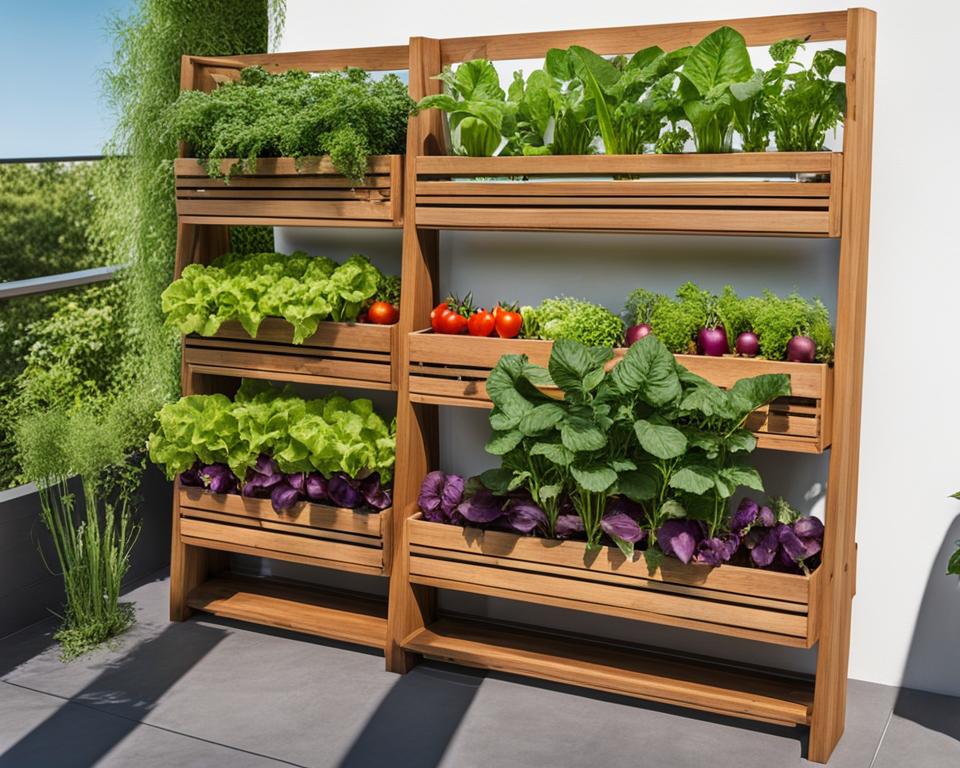
Embarking on the journey of vertical vegetable gardening for beginners can be both exciting and a little daunting. However, with a few strategic vertical gardening tips, you’ll find that growing upwards is not just space-efficient but can transform your garden into a lush, vertical oasis. To guide you along your new green thumb adventure, let’s delve into some essentials for achieving gardening success.
First and foremost, the key to a flourishing vertical vegetable garden lies in choosing the right plants. Opt for vining and climbing plants that are known for their vertical growing habits, such as tomatoes, peas, and cucumbers. These plants not only naturally reach for the sky but also require less surface area on the ground, allowing you to maximize your available space.
- Start with easy-to-grow species like beans and peas.
- Ensure your structures are robust enough to support the weight of mature plants.
- Use trailing plants like squash to create natural shade for more delicate greens below.
When it comes to building your vertical garden, stability is of utmost importance. Utilize sturdy trellises, cages, and support frameworks that can handle the elements and the weight of your produce. The support you choose will become the backbone of your vertical garden, so investing in quality materials is essential.
Remember, the success of vertical gardening often hinges on how well you can provide sunlight and water to your plants. Position your garden where it will receive plenty of light, and consider a drip irrigation system to keep the watering consistent and efficient.
In conclusion, as you dive into vertical vegetable gardening for beginners, keep in mind that trial and error is part of the process. Use these vertical gardening tips as your starting point and don’t be afraid to get creative with your space. With a little patience and care, your vertical garden will not only be productive but also a stunning feature in your home.
Maximize Your Harvest: Growing Vegetables in Small Spaces

If you’re determined to turn your limited outdoor space into a thriving garden, understanding how to start vertical gardening can transform your approach to urban agriculture. For city dwellers or those with compact gardens, the innovative solutions of vertical gardening open up a new dimension in homegrown produce. In this section, we’ll delve into the effective utilization of vertical space and explore a variety of creative containers and modular systems that are both functional and visually striking.
Effective Use of Vertical Space in Urban Settings
The key to growing vegetables in small spaces is to think beyond the horizontal plane. Urban settings often provide limited ground area, making vertical gardening ideas not only a necessity but also a smart approach to increase your yield. With structures like trellises, garden towers, and vertical wall planters, you’re able to cultivate a surprising variety of produce without sprawling garden beds. Additionally, these vertical elements can create a green oasis right in the heart of the city, offering a breath of fresh air and a personal connection to nature.
Creative Containers and Modular Systems for Versatile Planting
Embracing vertical gardening doesn’t have to mean sacrificing style for functionality. By choosing creative containers such as recycled pallet gardens, you’re making an eco-friendly decision while also providing a rustic charm to your space. Modular systems like stackable and hanging planters offer the flexibility to rearrange or expand your garden as your needs evolve. These solutions not only serve as a focal point but also ensure that even in the smallest of spaces, your vertical garden can flourish and provide a plentiful harvest.
As you venture into the world of vertical gardening, remember that it’s not just about saving space—it’s about maximizing it. With the right setup, your vertical garden will be the envy of neighbors and a testament to what’s possible with a little creativity and dedication.
Conclusion
Vertical gardening encapsulates a transformative approach to urban horticulture by maximizing limited space with ingenious vertical gardening techniques. For you, the modern gardener navigating the constraints of tight living quarters, these upward-bound gardens unlock the potential for lush, vibrant harvests. The satisfaction of cultivating your array of vegetables, not just for sustenance but as an active participant in an eco-friendly initiative, is one of the many remarkable vertical gardening benefits.
Armed with vertical gardening tips and guided by a palette of tested techniques, your green refuge can thrive, defying the vertical limits. While city landscapes continue to expand skyward, so too does the opportunity for apartment balconies, compact yards, and rooftop nooks to become verdant strongholds. This horticultural trend not merely answers the call for space efficiency but also fosters community well-being, weaving green threads into the urban fabric.
Embarking on this green journey, remember that each climbing tendril and unfolding leaf is a testament to the adaptability and creativity inherent in vertical gardening. As you enrich your gardening knowledge and experience, the continued evolution of this gardening avenue promises a future where cultivation and city life grow ever more harmoniously intertwined. Your pursuit of an urban oasis, replete with homegrown vegetables, is more than just a hobby; it’s a forward-step in the green revolution of our time.
FAQ
What vegetables are best suited for vertical gardening?
Ideal vegetables for vertical gardening include climbing varieties such as pole beans, climbing peas, vining tomatoes, cucumbers, and certain squashes and melons. These plants naturally tend to climb or can be trained to grow vertically, making them perfect choices for vertical gardens.
What are some tips for starting a vertical vegetable garden?
To start vertical gardening, choose a suitable location with enough sunlight, select sturdy vertical structures for plant support, and pick appropriate vegetables that can grow upwards. Ensure your plants receive adequate water and regular maintenance. Start with easier-to-grow vines and use vertical space to provide shade to less sun-tolerant plants.
How can vertical gardening benefit urban dwellers with limited space?
Vertical gardening provides a space-efficient way to grow vegetables, making it ideal for those with limited outdoor areas. By growing plants upwards, urban gardeners can maximize their harvest in small spaces like balconies and patios, providing a sustainable food source and adding greenery to their living environment.
What are the ecological benefits of vertical gardening?
Vertical gardening promotes sustainability by enabling city residents to grow their own food, reducing the need for transportation and packaging associated with store-bought produce. It also adds aesthetic value, improves air quality, and encourages biodiversity in urban settings.
What types of structures can be used for vertical gardening?
Common structures for vertical gardening include trellises, arches, pallet gardens, and wall-mounted planters. These should be sturdy and able to support the weight of vegetation, ensuring a safe and productive growing environment for vertical gardening vegetables.
How does vertical gardening improve plant health?
Vertical gardening enhances plant health by improving air circulation and sun exposure, which helps to minimize the risk of plant diseases commonly found in more densely planted gardens. The upward growth structure also minimizes plant contact with the soil, reducing the likelihood of pest infestations and rot.
Can vertical gardens save water?
Although vertical gardens may require more frequent watering due to increased air circulation, incorporating a micro or drip irrigation system can save water by delivering it directly to the plant roots, minimizing evaporation and ensuring efficient use of water.
Are there any special techniques for increasing yields in vertical gardens?
Techniques for increasing yields include properly training plants to grow up the support structures, choosing the right varieties suited for vertical growth, and implementing efficient watering and fertilization practices. Managing sunlight exposure and ensuring good air flow around the plants are also critical measures to ensure healthy, productive plants and increased yields.
What should beginners know about vertical vegetable gardening?
Beginners should focus on choosing the right plants that are easier to manage in a vertical setting, ensuring that they have reliable support structures. It’s also important to start small, learn as you go, and take advantage of the vertical space to create not only a productive garden but also a beautiful green space.
What are some creative ways to use limited space for vertical gardening?
Utilize wall planters, repurposed pallets, or modular systems like tower gardens to cultivate vegetables in small spaces. In addition to saving ground space, these options can transform areas such as balconies and small yards into vibrant, attractive, and productive gardens.

